Optimization of PM2.5 Pollution Control in Residential Buildings Through Mechanical Ventilation Systems Under High Outdoor PM2.5 Levels in Chinese Cities
Abstract
1. Introduction
2. Theoretical Model of Mechanical Ventilation Systems
3. Methods for Determining Indoor and Outdoor PM2.5 Concentration
3.1. Outdoor PM2.5 Concentration
3.2. Indoor PM2.5 Concentration Control Standards
4. Analysis the Steady-State Model for Indoor PM2.5 Concentration
4.1. The Impact of Ventilation Rate and Filtration Efficiency on Indoor PM2.5 Concentration
4.2. Calculation of Filter Efficiency Based on Indoor Non-Guaranteed Days
5. Analysis of the Non-Steady State Model for Indoor PM2.5
5.1. The Impact of Filter Efficiency on Purification Time
- (1)
- When Cin > C∞, the purification time can be calculated according to Equation (5);
- (2)
- When Cin = C∞, Cin/C∞ is set to a value slightly larger than 1. When it is taken as 1.01, it can be considered that the PM2.5 concentration reaches a stable value [30], and the purification time is calculated according to Equation (5);
- (3)
- When Cin < C∞, Equation (5) is meaningless, indicating that the indoor PM2.5 concentration exceeds the standard. At this time, the filter efficiency should be readjusted until it conforms to the above two situations.
5.2. The Impact of Ventilation Rate on Purification Time
5.3. The Impact of Initial Indoor PM2.5 Concentration on Purification Time
6. Non-Steady State Control of Indoor PM2.5
7. Conclusions
- (1)
- When calculated using the steady-state model, implementation of M6 air filters can result in the number of days meeting the indoor standards reaching 317, 328, 312, and 347, achieving “excellent” indoor air quality proportions of 65.3%, 71.6%, 65.4%, and 72% respectively. With F9 filters, the “non-guaranteed days” reduced to 8, 8, 11, and 1 day respectively, while “excellent” air quality days increased to 81.5%, 86%, 84.5%, and 90.9%. Further upgrading to H10 filters resulted in “non-guaranteed days” of 7, 7, 8, and 0 days, with “excellent” air quality proportions reaching 87.4%, 90.8%, 86.6%, and 93.7% respectively.
- (2)
- The increase in the air exchange rate of mechanical ventilation systems exhibits a limited effect on steady-state calculations but significantly influences unsteady-state models. When the air exchange rate is elevated from 1 h−1 to 2 h−1, the number of indoor non-guaranteed days in Beijing, Xi’an, and Zhengzhou decreases markedly. Specifically, for F9 filters, the reduction rates are 53%, 43%, and 57%, respectively; for H10 filters, the rates are 66%, 52%, and 60%. Consequently, the number of indoor non-guaranteed days in Beijing, Xi’an, and Zhengzhou is reduced to 10, 10, and 11 days, respectively. In Wuhan, the number of indoor non-guaranteed days using F8 filters is 12 days, achieving an indoor air quality assurance rate of 97%.
- (3)
- When the fresh air system is equipped with H10 filters and the outdoor PM2.5 concentration is 150 μg/m3, the corresponding ventilation air exchange rate is 0.45 h−1. However, when the mechanical ventilation air exchange rate is increased to 1 h−1, the corresponding outdoor PM2.5 concentration rises to 176 μg/m3. In cases of severe outdoor pollution, where the outdoor PM2.5 concentration reaches 250 μg/m3, the air exchange rate must be further increased to 1.65 h−1 to ensure compliance with indoor PM2.5 concentration control requirements.
Author Contributions
Funding
Data Availability Statement
Conflicts of Interest
Nomenclature
| V | Volume of the house, m3 |
| Qf | Volume of fresh air, m3/h |
| Qi | Volume infiltrated through the building shell, m3/h |
| εf | Non-uniform mixing coefficient |
| P | Penetration coefficient |
| K | Indoor particle deposition rate, h−1 |
| Cout | Concentration of outdoor PM2.5, μg/m3 |
| Cin | Concentration of indoor PM2.5, μg/m3 |
| ηm | Filtration efficiency of the air filter |
| C0 | Initial concentration of indoor PM2.5, μg/m3 |
| n | Air exchange rate of mechanical ventilation, h−1 |
| a | Air exchange rate of infiltration, h−1 |
| C∞ | Steady-state concentration of indoor PM2.5, μg/m3 |
| R | Effective cleaning rate, h−1 |
References
- Abbey, D.E.; Burchette, R.J.; Knutsen, S.F.; McDonnell, W.F.; Lebowitz, M.D.; Enright, P.L. Long-term Particulate and Other Air Pollutants and Lung Function in Nonsmokers. Am. J. Respir. Crit. Care Med. 1998, 158, 289–298. [Google Scholar] [CrossRef]
- Song, Y.W.; Kim, S.E.; Park, J.C. Indoor Air Pollutant (PM10,CO2) Reduction Using a Vortex Exhaust Ventilation System in a Mock-up Room. Buildings 2025, 15, 144. [Google Scholar] [CrossRef]
- Martins, N.R.; Da, G.G.C. Impact of Outdoor PM2.5 on Natural Ventilation Usability in California’s Nondomestic Buildings. Appl. Energy 2017, 189, 711–724. [Google Scholar] [CrossRef]
- Liu, L.H.; Xiang, B.; Si, P.F.; Shi, L.J. A Mathematical Model for Predicting Indoor PM2.5 Concentration Considering Uneven Mixing and Fractional Efficiency of A Filter. Indoor Built Environ. 2024, 3, 451–464. [Google Scholar] [CrossRef]
- Li, Y.Q.; Fan, Y.J.; Zhi, C.Q. Multi-objective Optimization of Mechanical Ventilation with The Aid of Purifiers in Two Scenarios: Regular Operation and Mitigating The Spread of Respiratory Infectious Diseases. Build. Simul. 2023, 16, 795–811. [Google Scholar] [CrossRef]
- Barbosa, S.; Ip, K. Perspectives of Hybrid Ventilation Strategies for Office Buildings in the UK. Energy Build. 2014, 77, 335–344. [Google Scholar]
- Teh, K.J.L.; Razali, H.; Lim, C.H. Field Investigation of Thermal Comfort and Indoor Air Quality Analysis Using a Multi-Zone Approach in a Tropical Hypermarket. Buildings 2025, 15, 1677. [Google Scholar] [CrossRef]
- Xie, W.; Fan, Y.S.; Zhang, X.; Tian, G.J.; Si, P.S. A Mathematical Model for Predicting Indoor PM2.5 Concentration under Different Ventilation Methods in Residential Buildings. Build. Serv. Eng. Res. Technol. 2020, 41, 694–708. [Google Scholar] [CrossRef]
- Kim, J.H.; Kim, H.G.; Yeo, M.S. Ventilation and Filtration Control Strategy Considering PM2.5, IAQ, and System Energy. Atmosphere 2020, 11, 1140. [Google Scholar] [CrossRef]
- Haenninen, O.O.; Palonen, J.; Tuomisto, J.T.; Tuomi, T.Y.; Seppaenen, O.; Jantunen, M.J. Reduction Potential of Urban PM2.5 Mortality Risk Using Modern Ventilation Systems in Buildings. Indoor Air 2005, 15, 246–256. [Google Scholar] [CrossRef]
- Kulmala, M.; Asmi, A.; Pirjola, L. Indoor Air Aerosol Model: The Effect of Outdoor Air, Filtration and Ventilation on Indoor Concentrations. Atmos. Environ. 1999, 33, 2133–2144. [Google Scholar] [CrossRef]
- Jamriska, M.; Morawska, L.; Ensor, D.S. Control Strategies for Sub-micrometer Particles Indoors: Model Study of Air Filtration and Ventilation. Indoor Air 2003, 13, 96–105. [Google Scholar] [CrossRef]
- Ben, D.T.; Waring, M.S. Impact of Natural Versus Mechanical Ventilation on Simulated Indoor Air Quality and Energy Consumption in Offices in Fourteen US Cities. Build. Environ. 2016, 104, 320–336. [Google Scholar] [CrossRef]
- Sawant, A.A.; Na, K.; Zhu, X.N.; Cocker, K.; Butt, S.; Song, C.; Cocker, D.R. Characterization of PM2.5 and Selected Gas-phase Compounds at Multiple Indoor and Outdoor Sites in Mira Lo, California. Atmos. Environ. 2004, 38, 6269–6278. [Google Scholar] [CrossRef]
- Zender-Wiercz, E. Improving The Indoor Air Quality Using The Individual Air Supply System. Int. J. Environ. Sci. Techol. 2017, 15, 689. [Google Scholar] [CrossRef]
- Miller, S.L.; Facciola, N.A.; Toohey, D.; Zhai, J. Ultrafine and Fine Particulate Matter Inside and Outside of Mechanically Ventilated Buildings. Int. J. Environ. Res. Public Health 2017, 14, 128. [Google Scholar] [CrossRef] [PubMed]
- Ruan, T.C.; Rim, D.Y. Indoor Air Pollution in Office Buildings in Mega-cities: Effects of Filtration Efficiency and Outdoor Air Ventilation Rates. Sustain. Cities Soc. 2019, 49, 101609. [Google Scholar] [CrossRef]
- Brent, S.; Atila, N.; Siegel, J. The Effects of Filtration on Pressure Drop and Energy Consumption in Residential HVAC Systems. HVAC&R Res. 2010, 16, 273–294. [Google Scholar] [CrossRef]
- Montgomery, J.F.; Green, S.I.; Rogak, S.N.; Bartlett, K. Predicting The Energy Use and Operation Cost of HVAC Air Filters. Energy Build. 2012, 47, 643–650. [Google Scholar] [CrossRef]
- Kim, J.H.; Yeo, M.S. Effect of Flow Rate and Filter Efficiency on Indoor PM2.5 in Ventilation and Filtration Control. Atmosphere 2020, 11, 1061. [Google Scholar] [CrossRef]
- Xu, W.H. Calculation Method of Air Filter Efficiency in Comfort Air Conditioning. HVAC 2001, 31, 42–44. [Google Scholar]
- Wang, Q.Q.; Li, G.Z.; Zhu, R.X.; Wang, J.L.; Zhao, L.; Wang, X.F.; Meng, C. Determination of PM2.5 Outdoor Design Concentration for Air Filter Design and Selection. Build. Sci. 2015, 31, 71–77. [Google Scholar]
- Si, P.F.; Fan, Y.S.; Li, A.G.; Rong, X.Y.; Xie, W.; Gong, R. Optimization in Selection of The Filter for Central Air Conditioning System in Public Buildings. HVAC 2011, 41, 63–66. [Google Scholar]
- Zhang, C.Q.; Gao, J.; Zeng, L.J.; Ye, W. Filtering Load of Outdoor PM2.5 for Buildings Based on The Concept of Filtering Concentration Days. J. Tongji Univ. 2017, 45, 1345–1351. [Google Scholar]
- Tu, Y.; Tu, G.B.; Wang, C. Discussion on Filtering Measures to Smog for Air Conditioning and Ventilation Systems in Public Buildings. HVAC 2020, 50, 55–63. [Google Scholar]
- China National Environmental Monitoring Centre. China National Urban Air Quality Real-Time Release Platform. Available online: https://www.cnemc.cn/ (accessed on 1 January 2017).
- GB/T 18883-2002; Standards for Indoor Air Quality. Standards Press of China: Beijing, China, 2002.
- GB/T 18883-2022; Standards for Indoor Air Quality. Standards Press of China: Beijing, China, 2022.
- JGJ/T 309-2013; The Standard of The Measurement and Evaluation for Efficiency of Building Ventilation. China Architecture & Building Press: Beijing, China, 2013.
- ASHRAE 62.1-2016; Ventilation for Acceptable Indoor Air Quality. American National Standards Institute: Washington, DC, USA, 2019.
- Xie, W. Prediction and Control of Indoor PM2.5 Concentration Under Different Ventilation Modes in Residential Buildings. Ph.D. Thesis, Xi’an University of Architecture and Technology, Xi’an, China, 2022. [Google Scholar]
- Fan, Y.S.; Xie, W.; Zhang, X.; Yu, J.W.; Si, P.F. Pollution Characteristics of Indoor Particle Matter at Infiltration Ventilation Building. Chin. J. Environ. Eng. 2018, 12, 1128–1134. [Google Scholar]
- Ministry of Ecology and Environment of the People’s Republic of China. Available online: https://www.mee.gov.cn/ (accessed on 10 March 2017).
- GB 50736-2012; Design Code for Heating Ventilation and Air Conditioning of Civil Buildings. China Architecture & Building Press: Beijing, China, 2012.
- Lam, K.S.; Chan, F.S.; Fung, W.Y.; Lui, B.S.S.; Lau, L.W.L. Achieving “Excellent” Indoor Air Quality in Commercial Offices Equipped with Air-handling Unit-respirable Suspended Particulate. Indoor Air 2006, 16, 86–97. [Google Scholar] [CrossRef]
- Xu, Z.L. Principles of Air Cleanliness Technology; China Building Industry Press: Beijing, China, 2016. [Google Scholar]
- Xu, W.H.; Han, H. Critical Filtration Efficiency and Minimum Air Changes of Comfort Air Conditioning Systems. HVAC 2002, 32, 85–88. [Google Scholar]

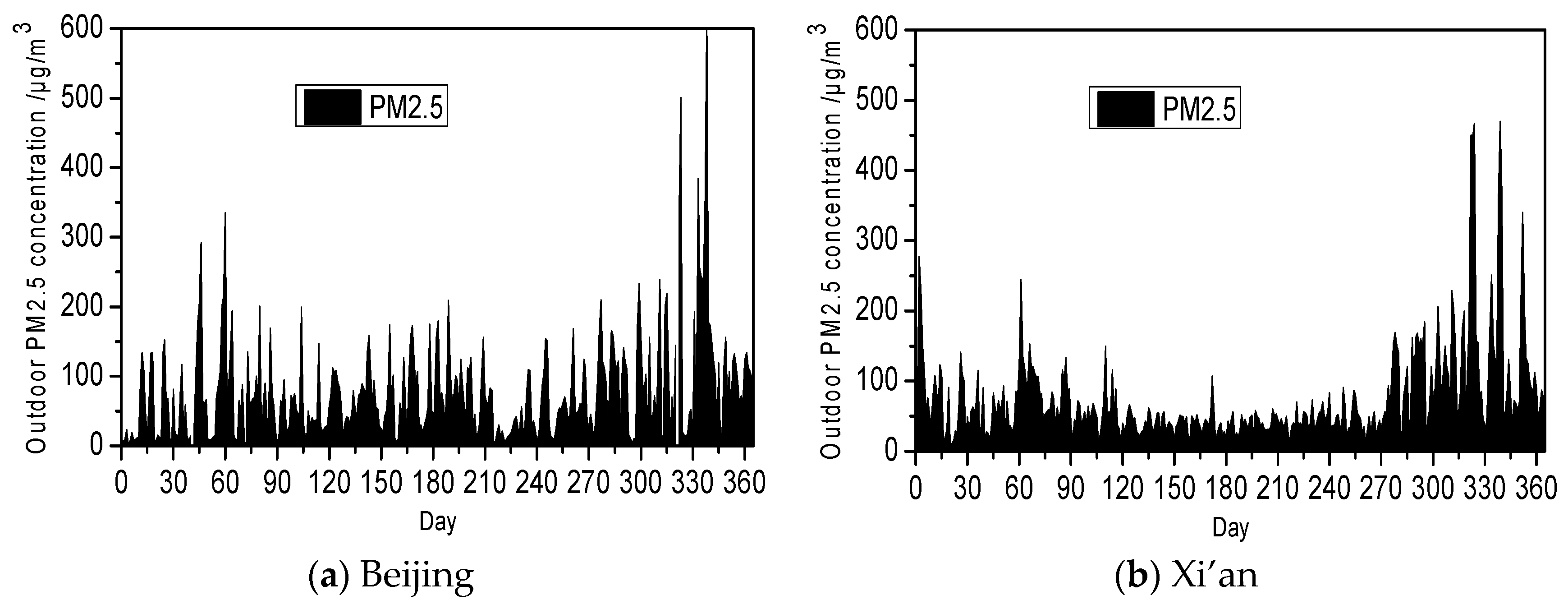

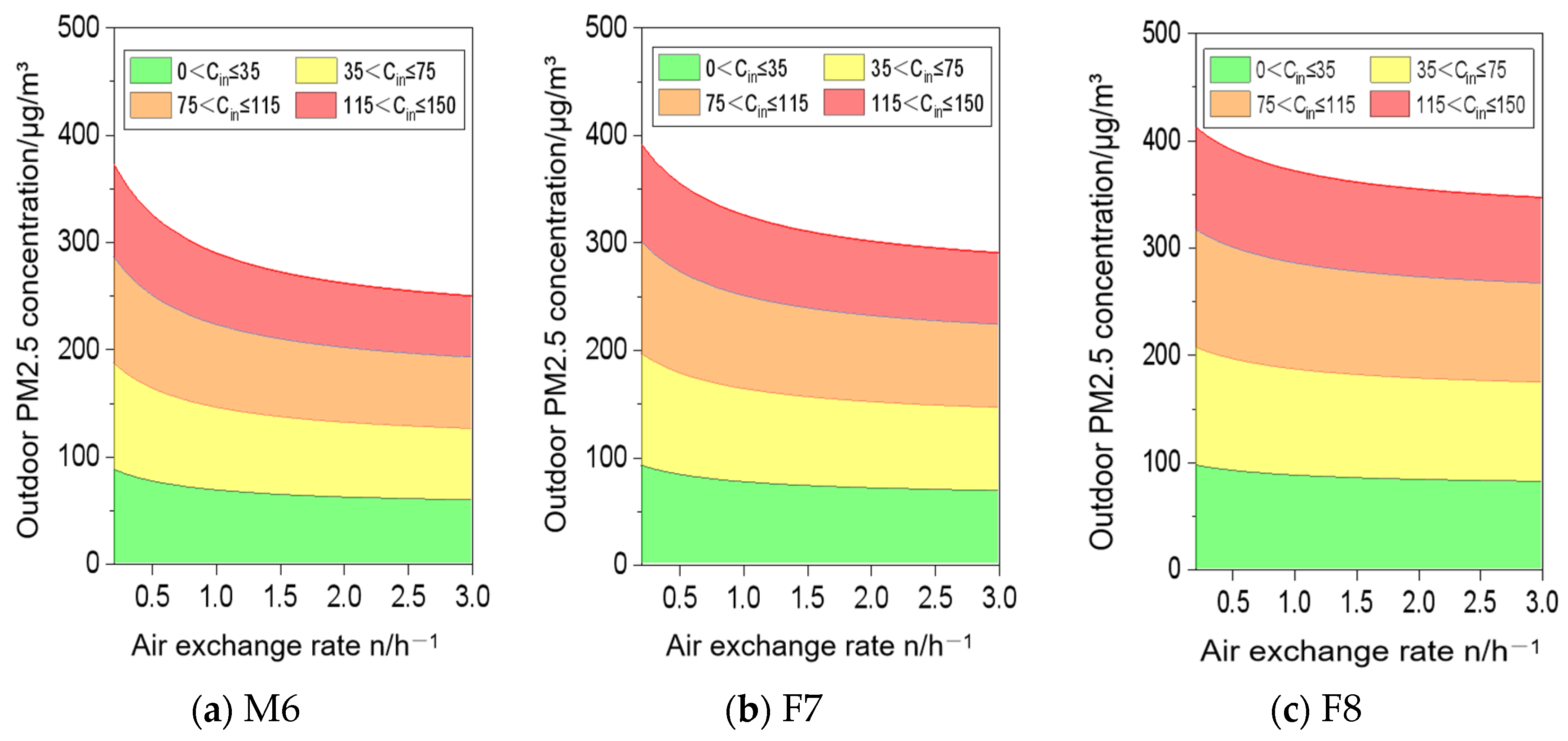
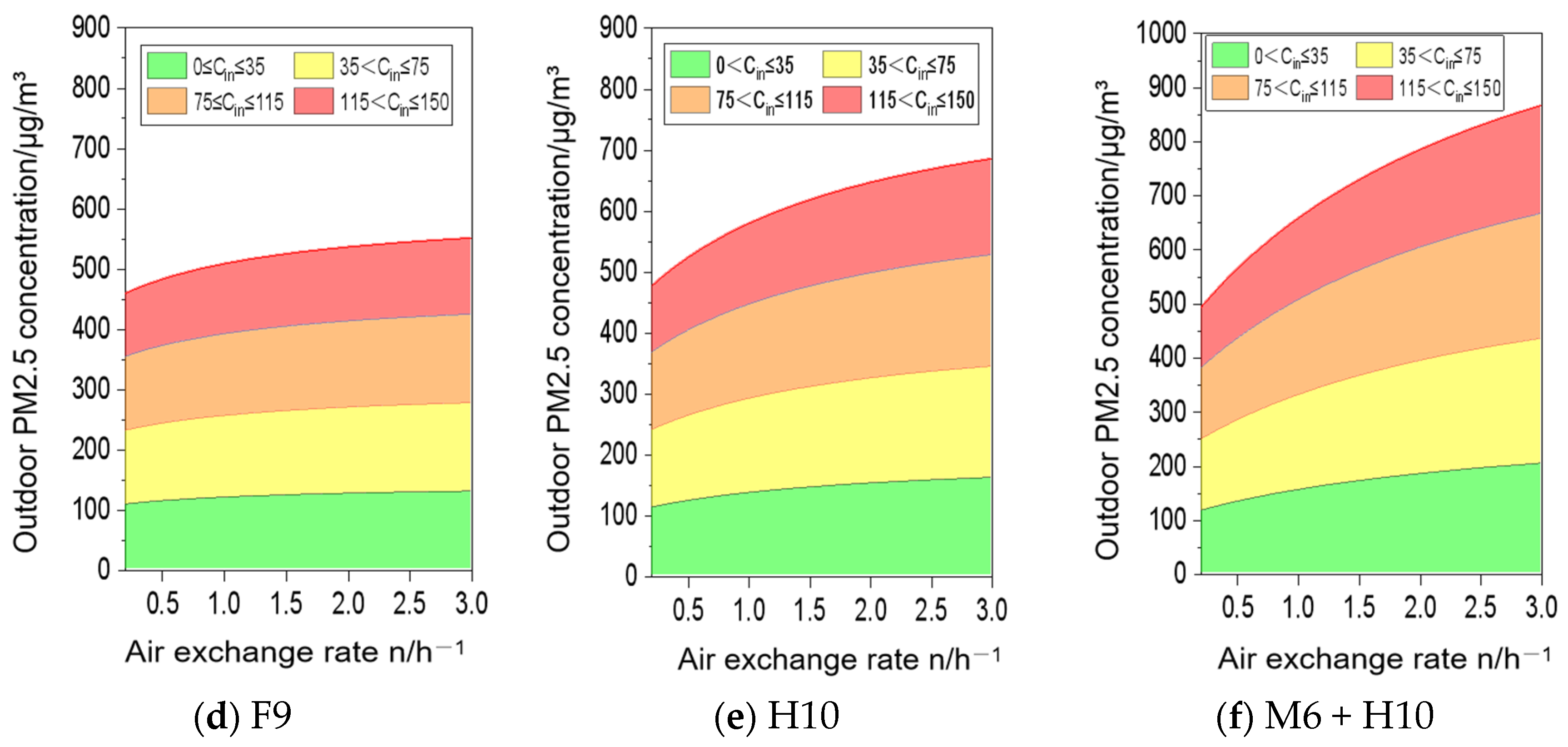


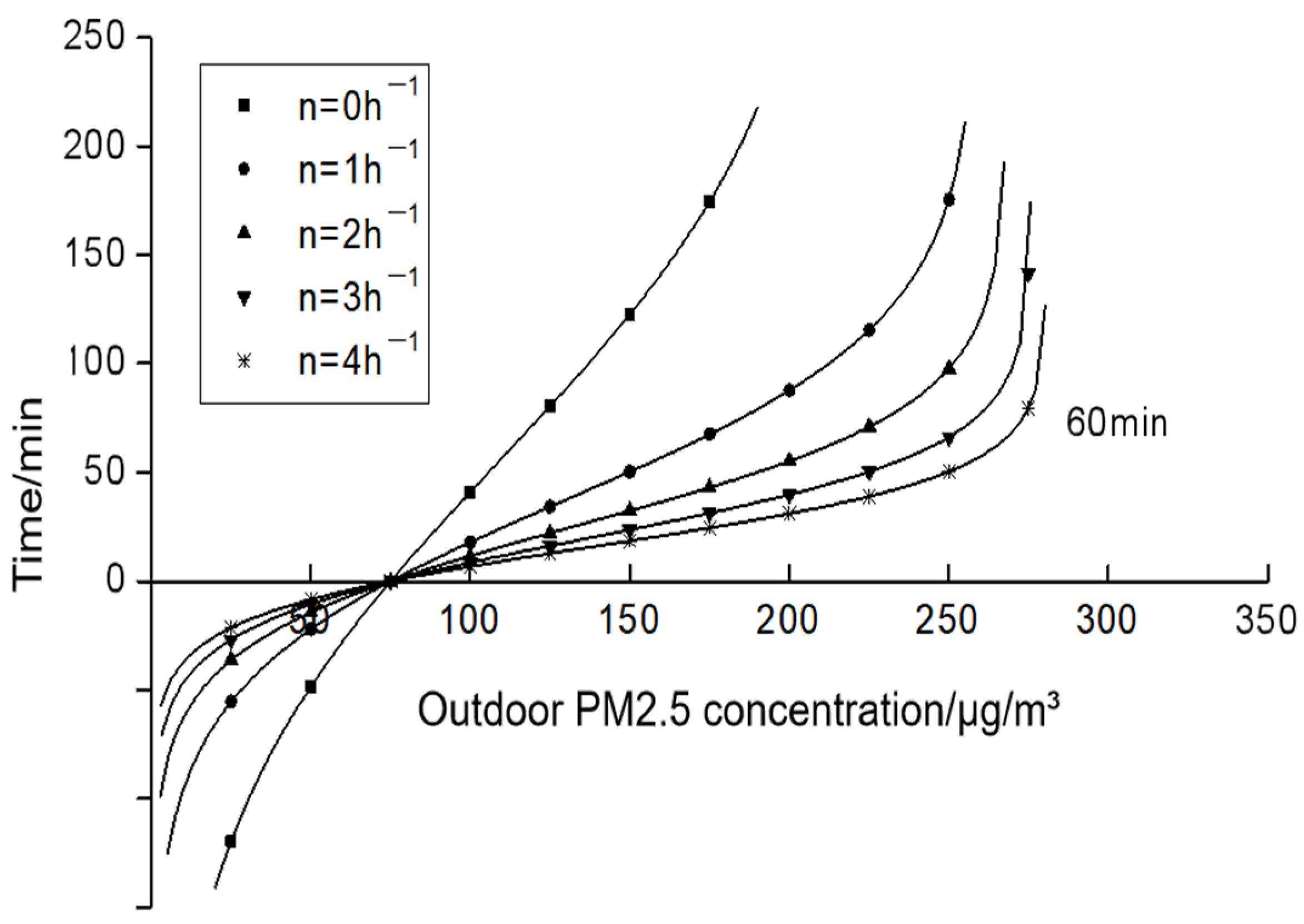
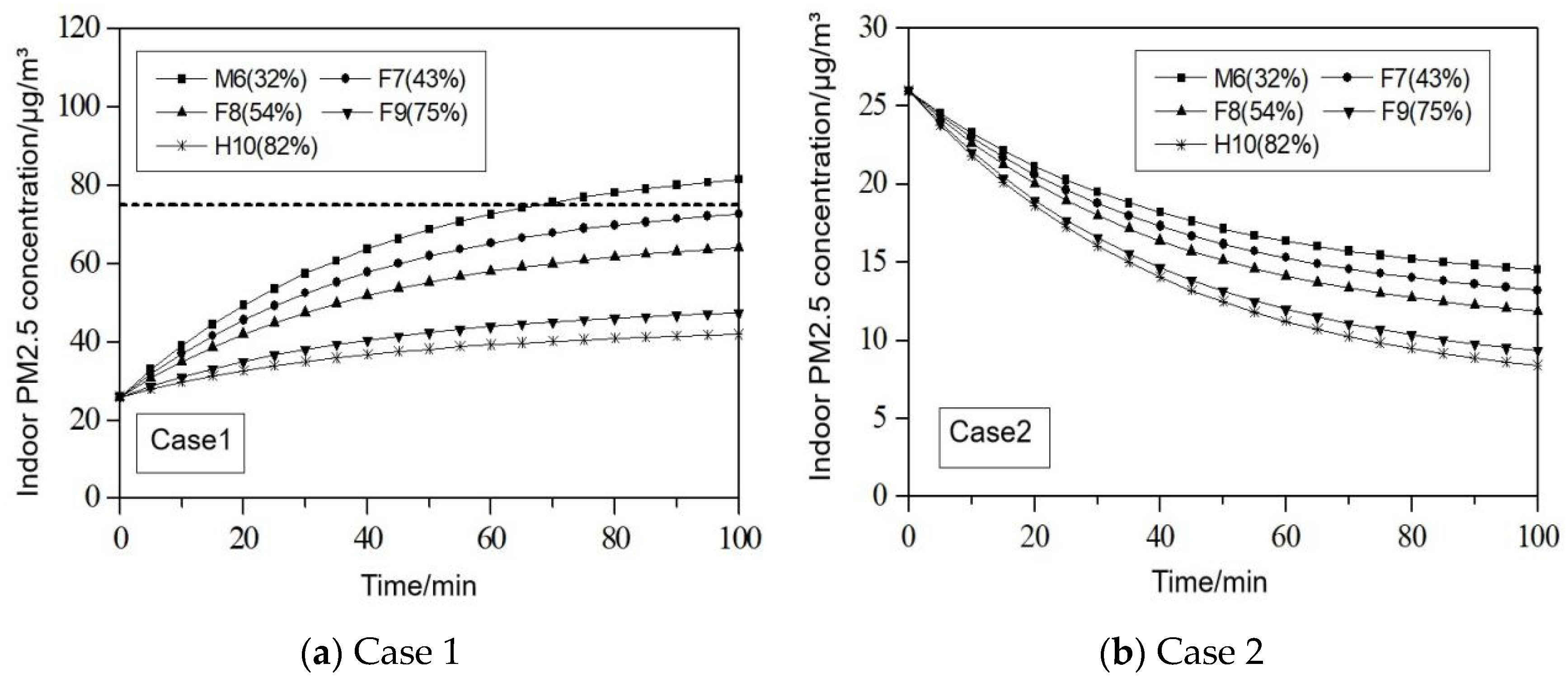
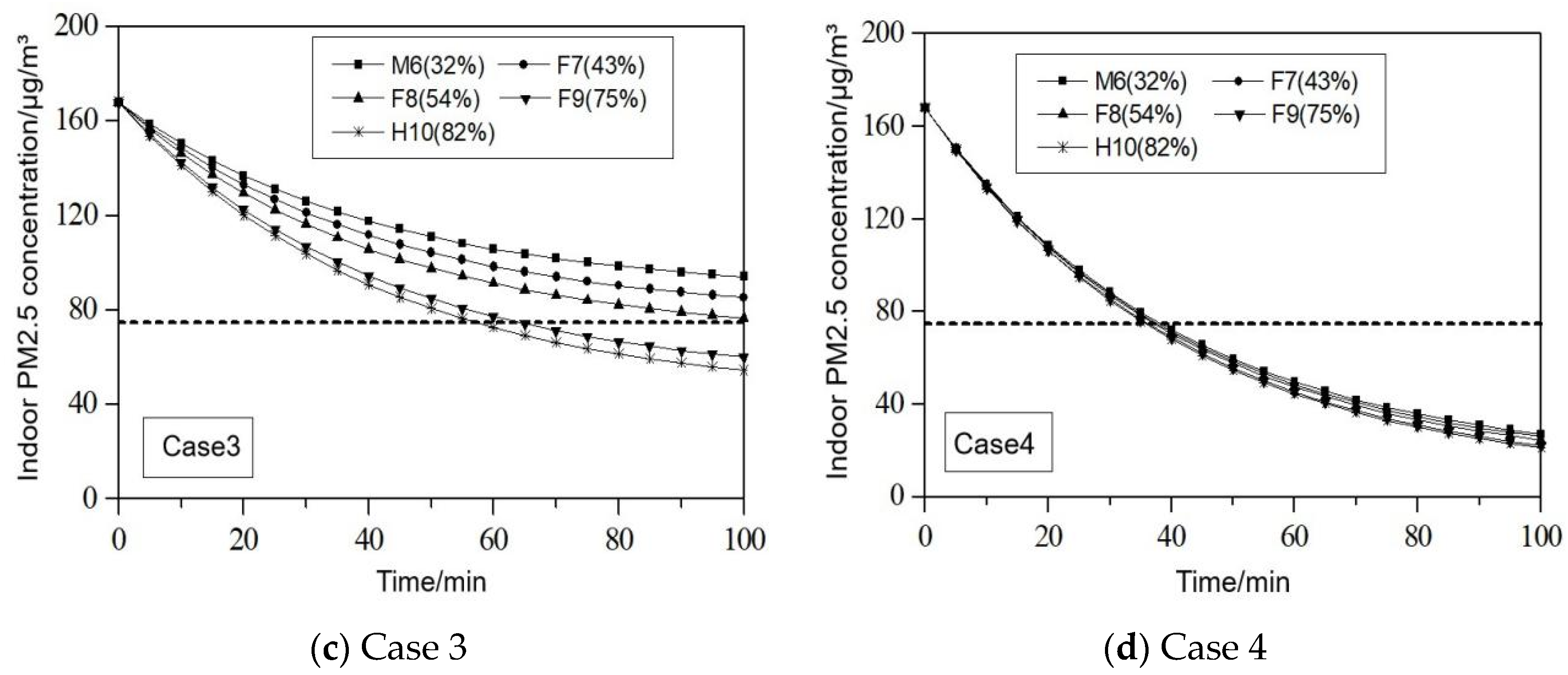
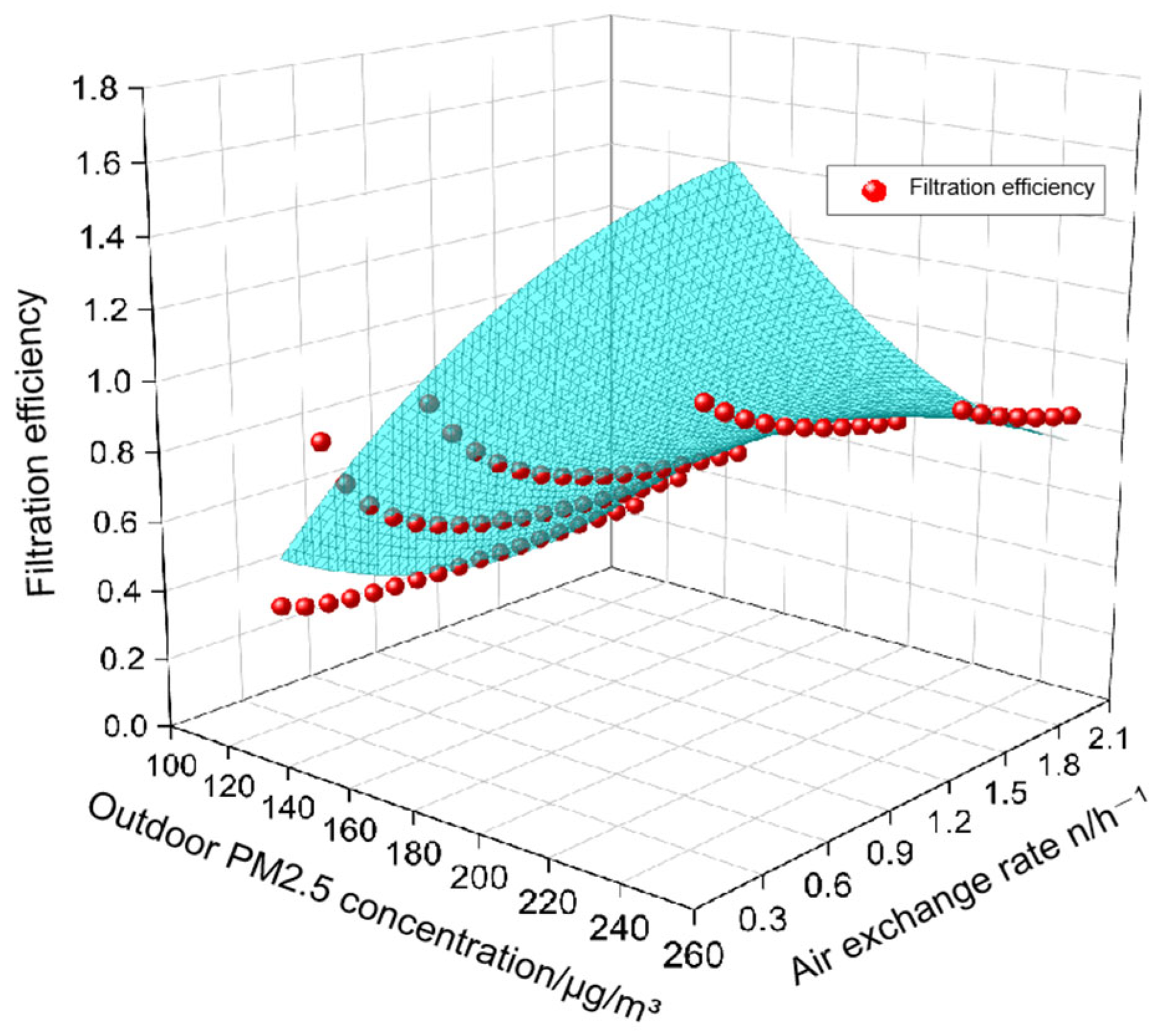
| Target Pollutant | China | United States | Europe | Canada |
|---|---|---|---|---|
| PM2.5 | 75 μg/m3 [24 h] | 15 μg/m3 [1 y] | 10 μg/m3 [1 y] | 100 μg/m3 [1 h] |
| 65 μg/m3 [24 h] | 25 μg/m3 [24 h] | 40 μg/m3 [L] |
| City | Filter Level | Calculation Model | Air Exchange Rate | |||
|---|---|---|---|---|---|---|
| 1 h−1 | 2 h−1 | 3 h−1 | 4 h−1 | |||
| Beijing | F8 | Steady-state | 24 | 26 | 28 | 30 |
| Non-steady-state | 52 | 44 | 35 | 34 | ||
| F9 | Steady-state | 8 | 7 | 7 | 7 | |
| Non-steady-state | 34 | 16 | 9 | 7 | ||
| H10 | Steady-state | 7 | 6 | 3 | 3 | |
| Non-steady-state | 29 | 10 | 7 | 6 | ||
| Xi’an | F8 | Steady-state | 17 | 19 | 20 | 21 |
| Non-steady-state | 40 | 28 | 25 | 23 | ||
| F9 | Steady-state | 8 | 8 | 8 | 7 | |
| Non-steady-state | 23 | 13 | 10 | 6 | ||
| H10 | Steady-state | 7 | 7 | 6 | 6 | |
| Non-steady-state | 21 | 10 | 7 | 7 | ||
| Zhengzhou | F8 | Steady-state | 24 | 26 | 27 | 27 |
| Non-steady-state | 56 | 39 | 30 | 29 | ||
| F9 | Steady-state | 11 | 10 | 9 | 8 | |
| Non-steady-state | 30 | 13 | 11 | 10 | ||
| H10 | Steady-state | 8 | 7 | 6 | 5 | |
| Non-steady-state | 27 | 11 | 8 | 7 | ||
| Wuhan | F8 | Steady-state | 5 | 5 | 5 | 6 |
| Non-steady-state | 21 | 12 | 8 | 7 | ||
| F9 | Steady-state | 1 | 0 | 0 | 0 | |
| Non-steady-state | 8 | 2 | 1 | 0 | ||
| H10 | Steady-state | 0 | 0 | 0 | 0 | |
| Non-steady-state | 5 | 1 | 0 | 0 | ||
| Working Condition | Outdoor PM2.5 Concentration Cout (μg/m3) | Initial Indoor PM2.5 Concentration C0 (μg/m3) |
|---|---|---|
| Case 1 | 168 | 26 |
| Case 2 | 26 | 26 |
| Case 3 | 168 | 168 |
| Case 4 | 26 | 168 |
Disclaimer/Publisher’s Note: The statements, opinions and data contained in all publications are solely those of the individual author(s) and contributor(s) and not of MDPI and/or the editor(s). MDPI and/or the editor(s) disclaim responsibility for any injury to people or property resulting from any ideas, methods, instructions or products referred to in the content. |
© 2025 by the authors. Licensee MDPI, Basel, Switzerland. This article is an open access article distributed under the terms and conditions of the Creative Commons Attribution (CC BY) license (https://creativecommons.org/licenses/by/4.0/).
Share and Cite
Xie, W.; Fan, Y.; Hu, P.; Si, P. Optimization of PM2.5 Pollution Control in Residential Buildings Through Mechanical Ventilation Systems Under High Outdoor PM2.5 Levels in Chinese Cities. Buildings 2025, 15, 2838. https://doi.org/10.3390/buildings15162838
Xie W, Fan Y, Hu P, Si P. Optimization of PM2.5 Pollution Control in Residential Buildings Through Mechanical Ventilation Systems Under High Outdoor PM2.5 Levels in Chinese Cities. Buildings. 2025; 15(16):2838. https://doi.org/10.3390/buildings15162838
Chicago/Turabian StyleXie, Wei, Yuesheng Fan, Pingfang Hu, and Pengfei Si. 2025. "Optimization of PM2.5 Pollution Control in Residential Buildings Through Mechanical Ventilation Systems Under High Outdoor PM2.5 Levels in Chinese Cities" Buildings 15, no. 16: 2838. https://doi.org/10.3390/buildings15162838
APA StyleXie, W., Fan, Y., Hu, P., & Si, P. (2025). Optimization of PM2.5 Pollution Control in Residential Buildings Through Mechanical Ventilation Systems Under High Outdoor PM2.5 Levels in Chinese Cities. Buildings, 15(16), 2838. https://doi.org/10.3390/buildings15162838






